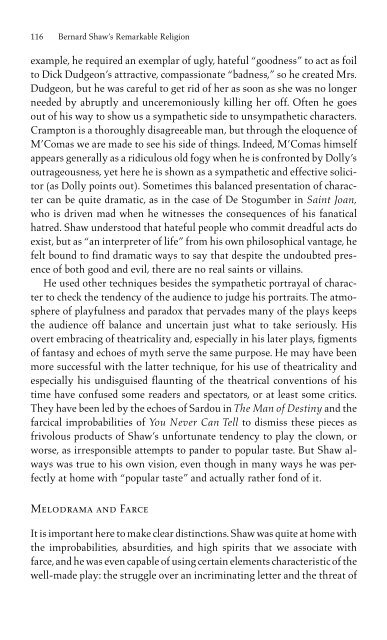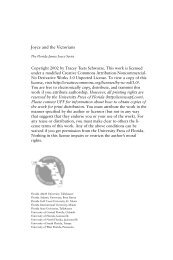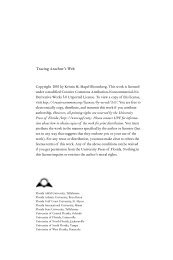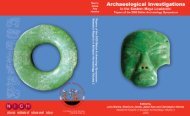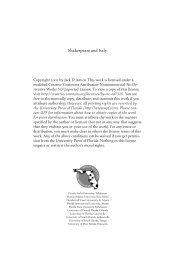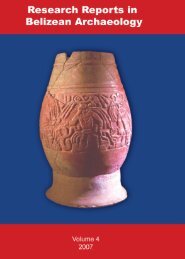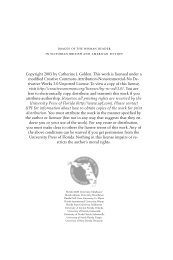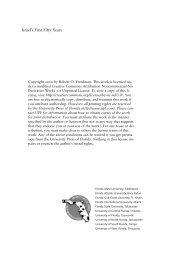Bernard Shaw's Remarkable Religion: A Faith That Fits the Facts
Bernard Shaw's Remarkable Religion: A Faith That Fits the Facts
Bernard Shaw's Remarkable Religion: A Faith That Fits the Facts
Create successful ePaper yourself
Turn your PDF publications into a flip-book with our unique Google optimized e-Paper software.
116 <strong>Bernard</strong> Shaw’s <strong>Remarkable</strong> <strong>Religion</strong><br />
example, he required an exemplar of ugly, hateful “goodness” to act as foil<br />
to Dick Dudgeon’s attractive, compassionate “badness,” so he created Mrs.<br />
Dudgeon, but he was careful to get rid of her as soon as she was no longer<br />
needed by abruptly and unceremoniously killing her off. Often he goes<br />
out of his way to show us a sympa<strong>the</strong>tic side to unsympa<strong>the</strong>tic characters.<br />
Crampton is a thoroughly disagreeable man, but through <strong>the</strong> eloquence of<br />
M’Comas we are made to see his side of things. Indeed, M’Comas himself<br />
appears generally as a ridiculous old fogy when he is confronted by Dolly’s<br />
outrageousness, yet here he is shown as a sympa<strong>the</strong>tic and effective solicitor<br />
(as Dolly points out). Sometimes this balanced presentation of character<br />
can be quite dramatic, as in <strong>the</strong> case of De Stogumber in Saint Joan,<br />
who is driven mad when he witnesses <strong>the</strong> consequences of his fanatical<br />
hatred. Shaw understood that hateful people who commit dreadful acts do<br />
exist, but as “an interpreter of life” from his own philosophical vantage, he<br />
felt bound to find dramatic ways to say that despite <strong>the</strong> undoubted presence<br />
of both good and evil, <strong>the</strong>re are no real saints or villains.<br />
He used o<strong>the</strong>r techniques besides <strong>the</strong> sympa<strong>the</strong>tic portrayal of character<br />
to check <strong>the</strong> tendency of <strong>the</strong> audience to judge his portraits. The atmosphere<br />
of playfulness and paradox that pervades many of <strong>the</strong> plays keeps<br />
<strong>the</strong> audience off balance and uncertain just what to take seriously. His<br />
overt embracing of <strong>the</strong>atricality and, especially in his later plays, figments<br />
of fantasy and echoes of myth serve <strong>the</strong> same purpose. He may have been<br />
more successful with <strong>the</strong> latter technique, for his use of <strong>the</strong>atricality and<br />
especially his undisguised flaunting of <strong>the</strong> <strong>the</strong>atrical conventions of his<br />
time have confused some readers and spectators, or at least some critics.<br />
They have been led by <strong>the</strong> echoes of Sardou in The Man of Destiny and <strong>the</strong><br />
farcical improbabilities of You Never Can Tell to dismiss <strong>the</strong>se pieces as<br />
frivolous products of Shaw’s unfortunate tendency to play <strong>the</strong> clown, or<br />
worse, as irresponsible attempts to pander to popular taste. But Shaw always<br />
was true to his own vision, even though in many ways he was perfectly<br />
at home with “popular taste” and actually ra<strong>the</strong>r fond of it.<br />
Melodrama and Farce<br />
It is important here to make clear distinctions. Shaw was quite at home with<br />
<strong>the</strong> improbabilities, absurdities, and high spirits that we associate with<br />
farce, and he was even capable of using certain elements characteristic of <strong>the</strong><br />
well-made play: <strong>the</strong> struggle over an incriminating letter and <strong>the</strong> threat of


